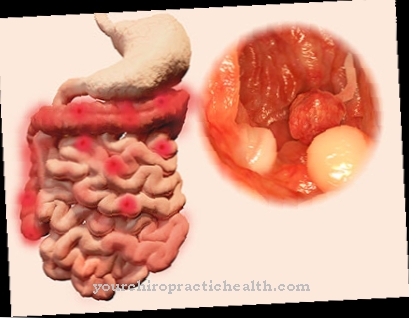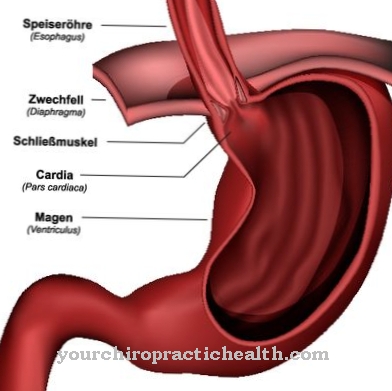As Club hand This is a congenital malformation of the forearm. A distinction can be made between a so-called radial and an ulnar shape.
What is a club hand?
At a Club hand it is a flexion contracture of the hand, whereby a distinction can be made between a radial and an ulnar shape. The metatarsophalangeal joints of the fingers also very often show flexion contractures, while the end and middle joints are more prone to extension contractures. Most of the time, the hand also lags behind in growth.
causes
A radial club hand usually occurs spontaneously and is usually not hereditary, but is considered an independent malformation. The misalignment is caused by a missing or shortened radius. This causes the hand to deviate from the normal position, whereby the radius is more often affected.
The malformations of the ulna and radius are often genetically determined, with the so-called TAR syndrome, VATER syndrome or Rothmund-Thomson syndrome, among others, causing a radial club hand. Cornelia de Lange syndrome or femur-fibula-ulna syndrome, for example, can be the cause of ulnar club hands.
Symptoms, ailments & signs
A typical feature of a club hand is the shortened forearm, and the hand deviates at right angles, radially. The function of the hand is very limited and gripping can only be carried out by clamping things between the forearm and hand. Most of the time, there are also anomalies of the wrist roots or hypoplasia of the long fingers and thumb.
In addition, it is possible to differentiate between a primary and a secondary club hand. A primary club hand is understood to mean a hereditary disease, with certain muscle groups being shortened or poorly differentiated. The bones develop normally. In the radial form, the radial forearm muscles or the biceps are predominantly affected; in the ulnar form, changes occur to the forearm muscles and the triceps.
The secondary club hand is due to a congenital ulna or radius defect. The hand deviates to the side and the deformity becomes coarser as it grows. In addition, deformities can occur on the neighboring joints or on the fingers. With an ulnar club hand, the palm of the hand points towards the body and the wrist and elbow are unstable.
In addition, pronounced finger defects and accompanying malformations that affect the muscles and the skeletal system occur. With a radial club hand, the back of the hand points towards the body, the wrist is dislocated, but the elbow is stable. Those affected mainly suffer from thumb defects, whereas the ulnar fingers are quite normal. Concomitant malformations mainly affect the gastrointestinal and cardiorespiratory systems.
Diagnosis & course of disease
A club hand is very noticeable because the arm is shortened and the forearm is bent outwards or inwards. There are individually different characteristics. There is a possibility that the elbow is completely stiff and unstable, the ulnar fingers can also be missing and the other fingers can develop so-called camptodactyly (flexion contracture) or syndactyly (malformation of the phalanx). The malformations of the elbow joint, wrist and hand are very clearly visible in the X-ray image.
Complications
The club hand usually leads to malformations in the lower area of the patient's arm. This can lead to severe restrictions in the patient's everyday life. Child development is also often disturbed by this malformation. Likewise, the normal gripping or lifting can no longer be carried out easily.
Most patients cannot pick up objects unless they pinch them between their hand and forearm. It is also not uncommon for muscles to be weak and the patient's resilience to be reduced. Certain sporting activities may also no longer be possible. It is not uncommon for fingers or joints to be affected by the deformities.
Children can also suffer from mental health problems or depression through the club hand when it comes to teasing or bullying. The club hand can be treated relatively well, without any particular complications. The symptoms can be resolved with the help of therapies or surgery. There are no further complications. Life expectancy is not reduced by a club hand either.
When should you go to the doctor?
A club hand is usually recognized and surgically treated immediately after birth. A slight malformation does not necessarily have to be corrected, but should still be examined by a doctor. The affected child often needs physiotherapy and orthopedic aids, which must be organized in cooperation with a specialist. Serious malformations must always be treated surgically. Parents of affected children should arrange for an operation at an early stage so that the club hand can be corrected before the child grows and the malformation may become even more pronounced.
If the club hand only develops in the course of the first few years of life, medical advice must also be obtained. Malformations of the wrist, hand and elbow joint are a reason for a doctor's visit. Furthermore, you should go to the doctor with a club hand if it occurs in the context of an already diagnosed disease such as the TAR syndrome or the VATER syndrome. Depending on the cause and severity of the club hand, parents can consult a general practitioner, an orthopedic surgeon or an internist. Hereditary diseases should be examined and treated in a specialist hereditary disease clinic.
Therapy & Treatment
The therapy of a club hand is either surgically or conservatively. Conservative treatment is usually indicated in the case of lighter forms, whereby in this form of therapy the contracture is counteracted and the shortening of the arm compensated. The arm is fixed with a splint or a plaster cast.
However, more severe malpositions can usually only be corrected through an operation. These corrections take place from the first year of life, whereby the fingers are separated or bony parts are removed during a surgical procedure. Today, the following surgical procedures are mainly used for this:
- Radial hypoplasia: At the age of two to three years, this method increases the radius. The operation may need to be repeated as the child grows.
- Subtotal or total radial plasia: Here, the ulna is centralized at two to three months, six months or in the third or fourth year of life.
Often the thumb is missing from a club hand or it is regressed. Since a grip function is not possible without the thumb, it must be reconstructed. There are two options for a reconstruction: Either a finger is converted into a thumb or a toe is transplanted.
The surgical procedure in which a thumb is simulated is called pollicization, with the index finger usually being used for this. Interventions on the elbow and forearm are usually only carried out during puberty so that the growth plates are not endangered. An exception is the Walther Blauth surgical method, which is already carried out in preschool age. In this case, the surgeon cuts the soft tissue on the wrist and then bolts the ulna into the wrist.
After the operation, the arm is immobilized for about four to six weeks, and constant monitoring by a specialist is necessary until the growth is complete. The therapy of a child's hand misalignment often proves to be extremely tedious and can take years. Due to the growth, new corrective interventions are often necessary. In the case of very severe malformations, usually only the functions can be improved, but not the cosmetic result, which is why psychological care is also part of the therapy concept.
You can find your medication here
➔ Medicines for painOutlook & forecast
The club hand is a congenital malformation of the skeletal system. This cannot be changed either by self-help measures or by using alternative or natural healing methods. An alleviation of the symptoms can only be achieved with the possibilities of conventional medicine.
Without the use of medical care, impairments can increase over the course of life. The movement restrictions worsen, there is a risk of pain and severe emotional stress. The aim is to change and optimize the skeletal system in a surgical procedure or by using conservative procedures. The application of the methods used is associated with various risks and side effects. In addition, several interventions are often necessary within the child's growth and development process. This can result in complications and consequential damage.
Under optimal conditions, doctors achieve good functionality of the arm, hand and fingers in long-term treatment. Often fingers are simulated and then mobilized in targeted training. Nevertheless, due to the visual abnormalities and restrictions in everyday life, psychological irregularities are to be expected in many patients. These must be taken into account when making the overall prognosis, as they are often lengthy and are associated with a reduced quality of life.
prevention
Since a club hand is a congenital malformation, it cannot be prevented.
Aftercare
The actual aftercare takes place until the end of puberty. Then growth comes to a standstill at the latest. A reduction in the suffering from the club hand is then unlikely. The patient can live with a cosmetic improvement in everyday life, but mobility remains limited. The aim of aftercare for adults cannot, as usual, be to prevent the disease from recurring.
The hand treated during the growth phase is in a rigid form. Those affected have to spend their everyday lives with the corresponding restrictions in their private and professional areas. Psychotherapy may be indicated if the immutable circumstances result in a mental suffering. Children must be monitored after an initial procedure. Because the club hand often brings with it the need for another operation.
Even afterwards, some of the affected hand can change due to the growth phase. In order to achieve the desired result, quarterly or half-yearly presentations to the attending physician are recommended. This is the only way to avoid complications and unforeseen developments. Orthoses or splints can be adapted to the changed conditions at short notice. X-rays, which clearly show the malformations, serve as diagnostic instruments.
You can do that yourself
Lighter forms of club hand can often be treated with conservative methods. Less pronounced malformations can be corrected by wearing a plaster cast or a splint. At the same time, the doctor will recommend that the patient take care of the affected hand.
If an operation is necessary, the affected hand must then be spared for at least four to six weeks. In addition, constant monitoring by a specialist is necessary. Only when the doctor gives his consent can major physical work be carried out again. In children with club hands, the parents should initiate an operation as early as possible, otherwise further complications can arise in the development process.
If the club hand puts a lot of strain on the patient and has possibly already caused emotional problems, therapeutic treatment is indicated. Participation in a self-help group can give those affected courage and thus make it easier to deal with the malformation. A club hand should always be monitored by a doctor. Even with lighter forms, complications such as premature joint wear or circulatory disorders can result, which must be clarified and, if necessary, treated. If symptoms suddenly appear, a doctor should be consulted.

.jpg)
.jpg)
























